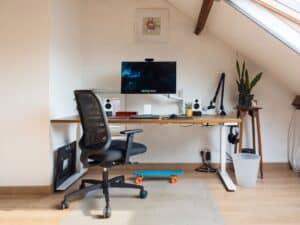Conference rooms play a crucial role in modern workplaces. They are spaces where important meetings, brainstorming sessions, and collaborative work take place. As such, it is essential to create an environment that is not only conducive to productivity but also comfortable for employees. One key aspect of creating a comfortable conference room is the seating. The right seating can make a significant difference in the overall experience and effectiveness of meetings.
Seating plays a vital role in creating a productive and comfortable environment in conference rooms. Uncomfortable seating can lead to various issues such as back pain, poor posture, and decreased focus. On the other hand, comfortable seating can enhance employee engagement, improve concentration, and promote better communication. Therefore, investing in high-quality and ergonomic conference room chairs is essential for creating a space that fosters productivity and collaboration.
Key Takeaways
- Comfortable conference room seating is crucial for productivity and engagement.
- Poor seating can lead to physical discomfort and distraction during meetings.
- Ergonomic seating can improve posture and reduce discomfort.
- Innovative seating arrangements can maximize space and functionality.
- Smart seating solutions can incorporate technology and boost collaboration.
Understanding the Impact of Seating on Productivity and Engagement
Uncomfortable seating can have a detrimental impact on employee health and productivity. Sitting for long periods in chairs that lack proper support can lead to back pain, neck strain, and other musculoskeletal issues. These physical discomforts can significantly affect an individual’s ability to concentrate and engage in meetings. Employees may find themselves constantly shifting in their seats or feeling restless due to discomfort, which can hinder their ability to actively participate in discussions.
Ergonomic seating is designed to reduce discomfort and improve engagement. Ergonomic chairs are adjustable, allowing individuals to customize the chair’s height, seat depth, and backrest position to fit their unique body shape and size. These chairs provide proper lumbar support, promoting good posture and reducing the risk of back pain. By providing employees with ergonomic seating options, employers can create a more comfortable environment that supports their well-being and enhances their ability to focus and contribute effectively during meetings.
Common Problems with Conference Room Seating: Solutions and Alternatives
Traditional conference room chairs and tables often come with their own set of problems. Many of these chairs lack proper lumbar support, leading to poor posture and discomfort. The rigid design of traditional chairs can also restrict movement, making it difficult for individuals to shift positions or find a comfortable sitting posture. Additionally, the standard height of conference room tables may not be suitable for all individuals, leading to awkward positioning and strain on the neck and shoulders.
To address these issues, alternative seating options can be considered. Bean bags provide a relaxed and informal seating option that allows individuals to sit in various positions, promoting movement and comfort. Standing desks are another alternative that encourages employees to switch between sitting and standing, reducing the negative effects of prolonged sitting. Lounge chairs offer a more relaxed seating option for informal meetings or breakout sessions. By incorporating these alternative seating options into conference rooms, employers can provide employees with choices that cater to their individual preferences and needs.
The Benefits of Ergonomic Seating: Choosing the Right Chairs for Your Space
| Benefits of Ergonomic Seating | Metric |
|---|---|
| Reduced Back Pain | Studies show that ergonomic chairs can reduce back pain by up to 50%. |
| Improved Posture | Ergonomic chairs promote good posture by supporting the natural curve of the spine. |
| Increased Productivity | Employees who use ergonomic chairs report increased productivity and focus. |
| Reduced Risk of Injury | Ergonomic chairs can reduce the risk of musculoskeletal disorders and other workplace injuries. |
| Customizable Features | Ergonomic chairs offer customizable features such as adjustable seat height, lumbar support, and armrests. |
Ergonomic seating offers numerous benefits for conference rooms. These chairs are designed with the user’s comfort and well-being in mind. They provide proper lumbar support, adjustable features, and cushioning that conforms to the body’s contours. By promoting good posture and reducing discomfort, ergonomic chairs can significantly improve employee health and productivity during meetings.
When choosing ergonomic chairs for your conference room, there are several factors to consider. Firstly, look for chairs that have adjustable features such as seat height, backrest angle, and armrest height. This allows individuals to customize the chair to their specific needs and preferences. Secondly, consider the materials used in the chair’s construction. Breathable fabrics or mesh backrests can help regulate body temperature and prevent sweating during long meetings. Lastly, test the chairs before making a purchase. Sit in them for an extended period to ensure they provide adequate support and comfort.
Maximizing Space and Functionality: Innovative Seating Arrangements and Layouts
In addition to choosing the right chairs, the seating arrangement and layout of the conference room can also impact productivity and collaboration. Creative seating arrangements can maximize space and functionality, allowing for more effective communication and interaction among participants.
One popular seating arrangement is the U-shape layout, where chairs are arranged in a U-shape with a central table. This layout promotes face-to-face interaction and allows for easy visibility of presentations or visual aids. Another option is the theater-style layout, where chairs are arranged in rows facing a stage or presentation area. This layout is ideal for large meetings or presentations where participants need to focus on a central point.
Flexible seating arrangements are also gaining popularity in modern conference room design. These arrangements involve movable furniture that can be easily rearranged to accommodate different meeting formats and group sizes. By providing flexibility in seating arrangements, employers can create a dynamic environment that encourages collaboration and adaptability.
Incorporating Technology: Smart Seating Solutions for Modern Conference Rooms

Technology plays a significant role in modern workplaces, and conference rooms are no exception. Integrating technology into conference room seating can enhance productivity and streamline communication.
One example of smart seating solutions is the incorporation of charging stations into chairs or tables. This allows participants to charge their devices conveniently during meetings, ensuring that they have access to necessary information and resources. Built-in screens or monitors in chairs or tables can also facilitate presentations or video conferences, eliminating the need for additional equipment.
By incorporating technology into conference room seating, employers can create a seamless and efficient meeting experience that supports the use of digital tools and enhances collaboration.
Creating a Welcoming Environment: Stylish and Comfortable Seating Options
Conference room design should not only prioritize functionality but also aesthetics. Creating a welcoming environment with stylish and comfortable seating options can contribute to a positive meeting experience.
Leather chairs are a popular choice for conference rooms as they exude a sense of sophistication and elegance. They are also comfortable and durable, making them suitable for long meetings. Colorful bean bags can add a playful and relaxed vibe to the space, making it more inviting for informal discussions or brainstorming sessions.
When choosing seating options, consider the overall design and theme of the conference room. Select chairs that complement the room’s color scheme and style to create a cohesive and visually appealing space.
Boosting Collaboration and Communication: Group Seating and Interactive Furniture
Collaboration and communication are essential in conference rooms, and the seating arrangement can play a significant role in facilitating these interactions. Group seating options can encourage teamwork and active participation during meetings.
Circular or oval-shaped tables with chairs placed around them promote equal participation and open communication among participants. This seating arrangement allows everyone to have a clear view of each other, facilitating eye contact and engagement. Modular seating is another option that allows for flexible group arrangements. These seating options can be easily rearranged to accommodate different group sizes or meeting formats.
Interactive furniture, such as whiteboard tables, can also enhance collaboration in conference rooms. These tables have a writable surface that allows participants to jot down ideas or sketches during discussions. This promotes creativity and active engagement among participants.
Budget-Friendly Upgrades: Affordable Ways to Revamp Your Conference Room Seating
Revamping conference room seating doesn’t have to break the bank. There are several budget-friendly options available that can still provide comfort and functionality.
Consider purchasing second-hand furniture from office furniture resellers or online marketplaces. Many companies sell their used furniture at a fraction of the original cost, allowing you to acquire high-quality chairs at a lower price. Another option is to explore DIY projects. With some creativity and basic woodworking skills, you can transform old chairs into stylish and comfortable seating options.
Additionally, consider investing in chair accessories such as lumbar support cushions or seat cushions. These accessories can provide additional comfort and support to existing chairs without the need for a complete replacement.
The Importance of Prioritizing Comfort and Productivity in Conference Room Design
Creating comfortable and productive conference rooms should be a priority for employers. By investing in quality seating options, employers can improve employee health, engagement, and overall meeting experience. Ergonomic chairs provide the necessary support and adjustability to reduce discomfort and promote good posture. Alternative seating options, creative seating arrangements, and the integration of technology can further enhance productivity and collaboration.
In conclusion, conference room seating plays a crucial role in creating a conducive environment for meetings and collaborative work. Employers should prioritize comfort and productivity when designing conference rooms, considering factors such as ergonomic features, seating arrangements, and technology integration. By doing so, employers can create spaces that promote employee well-being, engagement, and effective communication.
If you’re looking for the perfect conference room seating that combines comfort and style, ProSeat Online has got you covered. In fact, they have an entire article dedicated to the importance of ergonomics in conference room seating. This article provides valuable insights on how to choose the right seating options that promote good posture and enhance productivity during meetings. To learn more about the significance of ergonomics in conference room seating, check out their informative article here.
FAQs
What is conference room seating?
Conference room seating refers to the arrangement of chairs and tables in a conference room to facilitate communication and collaboration among attendees.
What are the different types of conference room seating?
The different types of conference room seating include boardroom style, theater style, classroom style, U-shape style, and banquet style.
What is boardroom style seating?
Boardroom style seating is a type of conference room seating where attendees sit around a large table facing each other. This style is ideal for small to medium-sized meetings.
What is theater style seating?
Theater style seating is a type of conference room seating where chairs are arranged in rows facing a stage or a speaker. This style is ideal for large presentations or lectures.
What is classroom style seating?
Classroom style seating is a type of conference room seating where chairs and tables are arranged in rows facing the front of the room. This style is ideal for training sessions or workshops.
What is U-shape style seating?
U-shape style seating is a type of conference room seating where chairs and tables are arranged in a U-shape facing the front of the room. This style is ideal for small to medium-sized meetings where attendees need to interact with each other.
What is banquet style seating?
Banquet style seating is a type of conference room seating where round tables are arranged with chairs around them. This style is ideal for social events or dinners.
What factors should be considered when choosing conference room seating?
Factors that should be considered when choosing conference room seating include the number of attendees, the purpose of the meeting, the type of interaction required, and the available space.






